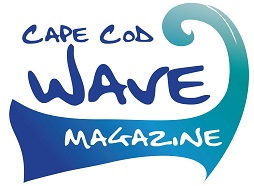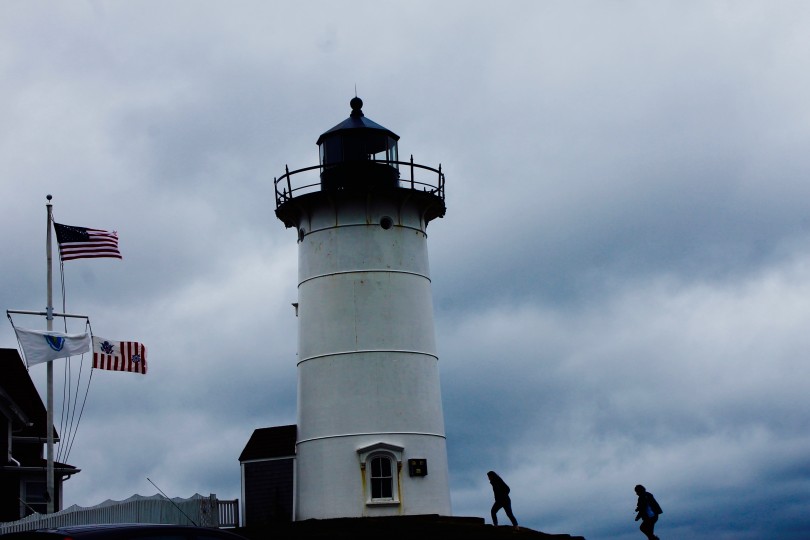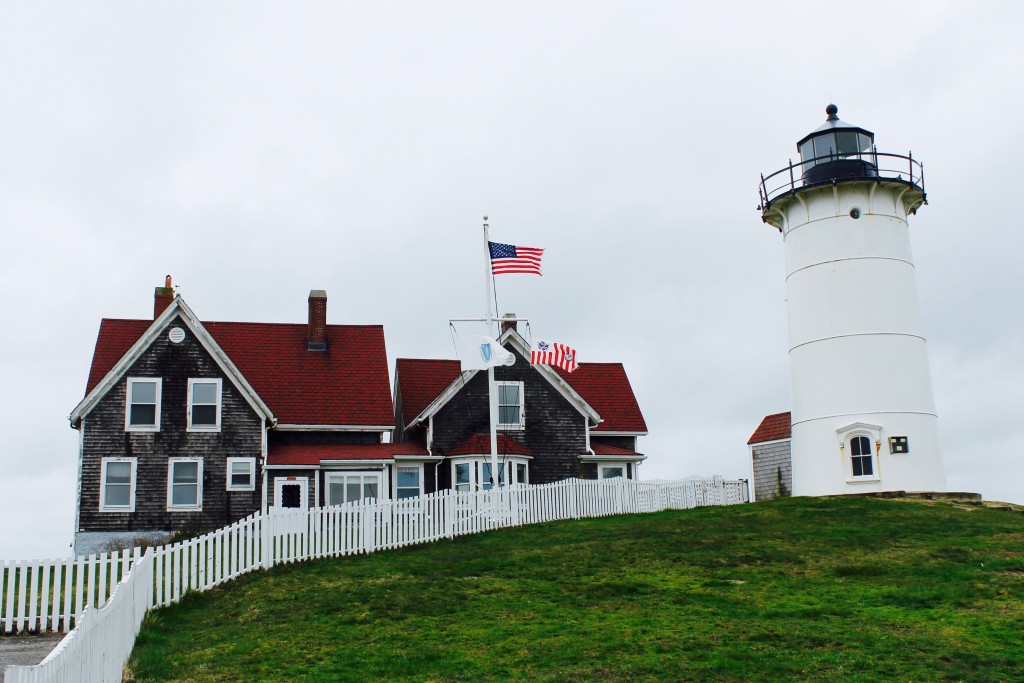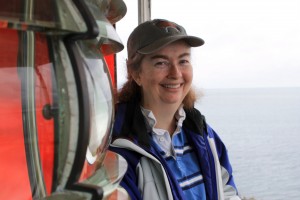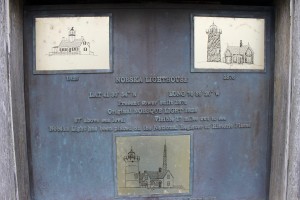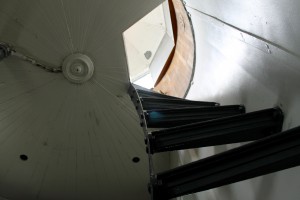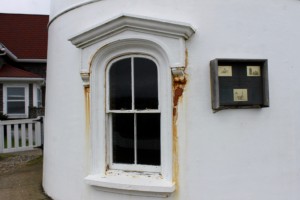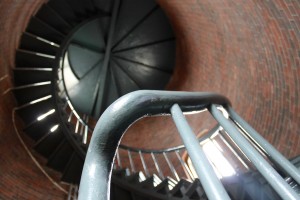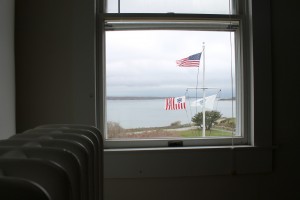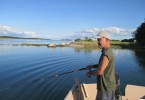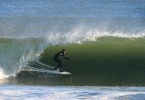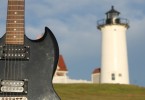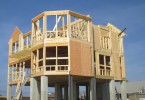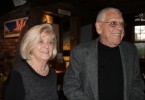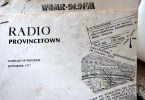WOODS HOLE – “When you are given the keys to a lighthouse, there’s no pretense that you own it,” said Brian Nickerson, a board member of Friends of Nobska Light, the non-profit that took over management of Nobska Lighthouse on Monday. “Everyone who visits owns it.”
On Monday, the Coast Guard, which has operated Nobska Lighthouse since 1915, licensed operation of Nobska to the town of Falmouth, which then granted stewardship to Friends of Nobska.
Friends of Nobska Light was founded by four non-profits: Historic Highfield, Falmouth Historical Society, Woods Hole Community Association, and Woods Hole Museum.
“Everyone who visits owns it.” – Brian Nickerson, board president of Friends of Nobska Light
“We were formed specifically to take over the restoration and management of Nobska Light Station,” said Catherine Bumpus, Executive Director of Friends of Nobska Light, and a board member of the Woods Hole Community Association.
“I think there’s a lot of passion and enthusiasm for it,” said Bumpus. “Quite fundamentally, it’s going to take the community to put Nobska on a firm foundation to keep it going.”
“I’m not sure where I heard it,” said former state representative Eric Turkington. “Somebody mentioned it. It was floating around.”
In late 2013, Turkington, a board member of the Woods Hole Community Association, was in Woods Hole when he heard a rumor that the Coast Guard was planning to dispose of Nobska Lighthouse. He brought word of what he heard to the association board meeting.
Later, Nickerson, president of the board of directors of the Falmouth Historical Society, heard the same thing, referring to it as “the unofficial scuttlebutt around town.”
This was no small rumor or irrelevant scuttlebutt. “There’s no other building in Falmouth that’s more iconic, more identified with Falmouth than Nobska Light,” said Nickerson. “None. Not even close.”
It turned out that the rumor was true.
According to Lt. Karen Love Kutkiewicz, public affairs officer for the First Coast Guard District, the keepers house in recent decades has been occupied by a succession of captains of the port of Woods Hole. The official title of those recent occupants, she said, is Sector Southeastern New England Commander.
But when needed repairs in the living quarters on the 2.11-acre property were deemed too expensive in 2013, the Coast Guard decided that Nobska Light “wasn’t up to standards for the Southeast Sector Commander to live there,” said Love Kutkiewicz.
Sometime after that, the scuttlebutt started.
According to Bumpus, it was Turkington who “knew that Nobska was empty and he was worried about it. He anticipated something was going to happen.”
Turkington said, “We knew about lighthouses elsewhere. (The Coast Guard) sometimes end up giving them to private people and they become B&Bs.”
Bumpus said that when Turkington brought it to the attention of the Woods Hole Community Association, “the reaction was, okay, let’s pay attention. This matters.”
Nickerson said that a meeting was held in Woods Hole to discuss Nobska. “Catherine chaired it,” said Nickerson. “She did all of her homework and gave a great presentation.”
“There’s been no arguing or fighting or turf squabbles. People just want to do it.” – Eric Tarkington, former state representative
Turkington said, “The consensus that came out of there, and it took a little while, was that this was too big of a thing for any single existing historical group to take on itself.”
In January 2014, four organizations came together to form Friends of Nobska Light. There are 14 board members, said Bumpus. “There are many people involved at all sorts of levels,” she said.
“This group has come together very nicely,” said Turkington. “People have taken the ball and run with it. There’s been no arguing or fighting or turf squabbles. People just want to do it.”
In June 2014, the Coast Guard put out a Notice Of Availability for the management of Nobska for the use under a no-cost license. It was being made available to federal state and local agencies, non-profit corporations, educational agencies or community development organizations for preservation and public access.
“The only letter of interest was submitted by this group through the town,” said Nickerson.
Turkington said, “The Coast Guard told us it was the best application they had ever seen.”
As a result, “The town of Falmouth has a 23-page license agreement,” said Love Kutkiewicz.
“The Coast Guard was formed in 1915 from a bunch of organizations, including the Lighthouse Service,” said Love Kutkiewicz. “We basically inherited all the lighthouses.”
In 1996, Love Kutkiewicz said, the National Historic Lighthouse Preservation Act required the Coast Guard to report on the state of all the lighthouses in the U.S. The Coast Guard was to determine whether granting management to another entity would be the preferred management option.
This began a process, she said, in which the Coast Guard “began leasing lighthouses to different entities.”
“The Coast Guard wants to make sure that all of these lighthouses are cared for by good stewards, like the town of Falmouth,” said Love Kutkiewicz. “The town has stated that they are dedicated to preserving the historical significance of Nobska Light.”
Some were leased to nonprofits, she said. If a nonprofit or government agency can not be found to take care of a lighthouse, it could be sold. Some lighthouses are now privately owned.
“A husband and wife own Graves Light in Boston Harbor,” said Love Kutkiewicz.
While the aids to navigation that a lighthouse provides – the light and foghorn – are still needed, Love Kutkiewicz said “because of automation we don’t have a need for lighthouse keepers.”
In fact, while the management or even the ownership of many lighthouses has been transferred to others, the Coast Guard still maintains the actual aids to navigation – the light and foghorn – on all lighthouses. They will continue to maintain the automated light and foghorn at Nobska, she said.
Nobska remained occupied until 2013, because it served as the home for the Sector Commander.
But needed repairs at Nobska, mostly to the the keepers house, were estimated in 2013 to be $550,000, said Love Kutkiewicz.
This year, Friends of Nobska Light estimated the repairs needed will cost $800,000, said Bumpus.
The current Nobska Lighthouse was built in 1876. It replaced the original lighthouse, which was built in 1829.
“The first lighthouse was a Cape style house, a story and a half with a tower in the middle of it,” said Bumpus. “It was a style they used in a number of different places. But the tower was too heavy for the beams in the middle, and the roofs all leaked.”
“From 1829 when it was built until 1973, civilian keepers working for the federal government, kept the light going,” said Bumpus. “In 1973, the last of the civilian lightkeepers retired and the active duty Coast Guard took it over as an active station. It housed people there that kept the light going.”
Through the years, Bumpus said that first the Lighthouse Service and then the Coast Guard “wanted keepers to have families so that the keeper would have built-in help.”
A lightkeeper’s house was built next to the tower in 1876, the year the tower was built. In 1905, about four feet from that first house, a second house was built for the assistant keeper, said Bumpus. In 1985, the two houses were joined together on the first floor to create one residence.
As Love Kutkiewicz pointed out, working in a Lighthouse before automation was “a really hard life.”
Nickerson said there are some logs of that from the keepers in the 1800s. “It’s sort of like an Excel spread sheet of 1865, how many ships are going by, what kind of ship.”
Bumpus said, “It was the responsibility of the lightkeepers to count the vessel traffic going by during the day.” Whaling ships from Nantucket Island would have passed Nobska, both leaving and returning from years-long journeys, she said.
“There was a quite lot of ships going by in the 1860s,” said Nickerson.
Of course, the other responsibility was to keep the light going.
In the early days, Bumpus said, the light “would have been fueled by whale oil, then by kerosene. They would have had to clean the lamps to keep them going. That Fresnel light that’s in there is from 1888,” she said. “That would have originally have had whale oil. They also would have had to sound the fog horn, or originally the fog bell.”
Turkington described climbing in the tower as “a good way to hit your head. It’s cramped and it’s got very hard metal. It’s not cozy or inviting. It’s very utilitarian.”
In 1985, the light became automated. Now, there is a sensor that knows when to send out light and also activates the foghorn, said Bumpus. There is a four-bulb changer in the light so if the bulb burns out, it is replaced automatically, said Bumpus.
In 1985, “It became the home to the commander of Coast Guard sector southeast New England,” said Bumpus. That was the year the two houses were joined into one.
The resident of the house changed when the commander changed, she said. This continued until 2013, when the house was deemed unfit for the commander.
On the Coast Guard fact sheet about Nobska that it included in its June 2014 Notice of Availability, the condition of the property is described this way: “The trim, sashes and flashing of windows have deteriorated. Wiring and heating needs to be updated, as well as roof and shingles. Other updates/repairs are needed throughout.”
In addition, the fact sheet says, “Asbestos-containing material and lead-base paint may be present throughout the structures.”
Because of possible asbestos and lead paint, Bumpus said, “We’re not buying it. The Coast Guard isn’t ready to sell it. They have not done a full assessment of the property. They have to decide whether or not they have any environmental responsibilities,” she said.
Instead, there is the licensing agreement. According to Love Kutkiewicz, “We want to make sure that these historical places are maintained because they are historical places, and also that the lights are maintained.”
That is why the light itself will continue to be maintained by the Coast Guard. But as of Monday, Nobska is in new hands.
“The goal is to restore and repair the keeper’s houses,” said Bumpus. “We’re in need of a lot of serious maintenance, and if it goes much longer, it will need more. We still have a weather-tight shell on both houses, but we’re not sure how much longer that will last,” she said.
“In the house, the windows are in very bad shape,” she said. “There are places we are seeing leaks. We did a big cleanup a couple of weeks ago and we were picking shingles up off the ground.”
Bumpus noted, “The roof has been patched.”
“It needs trim and paint. There’s rust on the tower. There’s broken pipes in the walls. We may need to address the septic system. We haven’t had time to do a full evaluation of the building yet,” said Bumpus.
She said Friends of Nobska Light so far has done “general homework” on what needs to be done. “We have had two different local builders in the building,” said Bumpus. “We have had conversations with people who are well-versed in historic buildings.”
The inside of the keeper’s houses “still looks good,” said Nickerson. But there are structural aspects that need to be dealt with, he said. “The actual lighthouse, the tower, needs some work inside and outside but structurally it’s fine. The major aspect will be the keeper’s houses,” he said.
Bumpus said, “We have a back-of-the-envelope calculation of about $800,000 in work that we’d like to undertake sooner rather than later.”
![]() Fundraising & The Future Of Nobska
Fundraising & The Future Of Nobska
“We will be looking for private donations, Community Preservation Act money, and other grant opportunities,” said Bumpus.
Since Friends of Nobska Light formed, Bumpus said the group has raised about $100,000. The bigger fundraising push will begin now that the Friends Of Nobska have the responsibility for maintenance, she said.
The overall goal is to raise $5 million as an endowment for ongoing improvements, said Nickerson. “Once we restore everything, it’s still a 150-year-old building,” he said.
Bumpus said, “We would like to put Nobska on a firm financial foundation so it can continue to operate and be well taken care of in the future,” she said.
Restorations are only one part of the coming changes at Nobska.
“The general overall goal is to open the keeper’s houses with historic interpretive information in them,” said Bumpus. “It may be as formal as a museum or we may call it an educational center. It’s a matter of semantics.”
“The Falmouth Historical Society has a large maritime collection, and the Woods Hole Museum has a smaller collection,” said Bumpus, who noted Nobska will be filled with maritime exhibits from both.
As for the tower, Nickerson noted that a civilian group, the Coast Guard Auxiliary, has been conducting tours of the tower for several years, and those small tours will hopefully resume once work is finished, he said.
Of course, opening the building up to the public could be a problem considering the limited parking. “Parking will be a challenge in the future,” said Bumpus.
“Being in Woods Hole, we understand there are constraints on how much space there is at any one time,” said Bumpus. “We are very aware of the constraints.”
But there is some room for a few new parking spots, she said.
“It’s a dilemma,” said Nickerson. “We have some ideas, but we never want to have enough parking. If we have enough parking there, we become a parking lot, and we don’t want to become that.”
“We would like to add a small modest increase in parking,” said Nickerson. “I can’t see more than a dozen spots.”
Turkington said, “No one wants Nobska to become a parking destination.”
“Nobska is really important to the Coast Guard family down on the Cape,” said Love Kutkiewicz. “Nobska Light has been in the Coast Guard family for so long, and the sector commander has lived there for so long.”
She called the license transfer “both sad and happy” for the Coast Guard. Then she added, “It’s a great day because we know the town of Falmouth is going to steward it well, and it’s going to be open to the public. Running it as the Coast Guard,” said Love Kutkiewicz, “we weren’t allowed to open it to the public.”
And, she added, “It’s better for the community when the community is involved. We’re not in the tourism business.”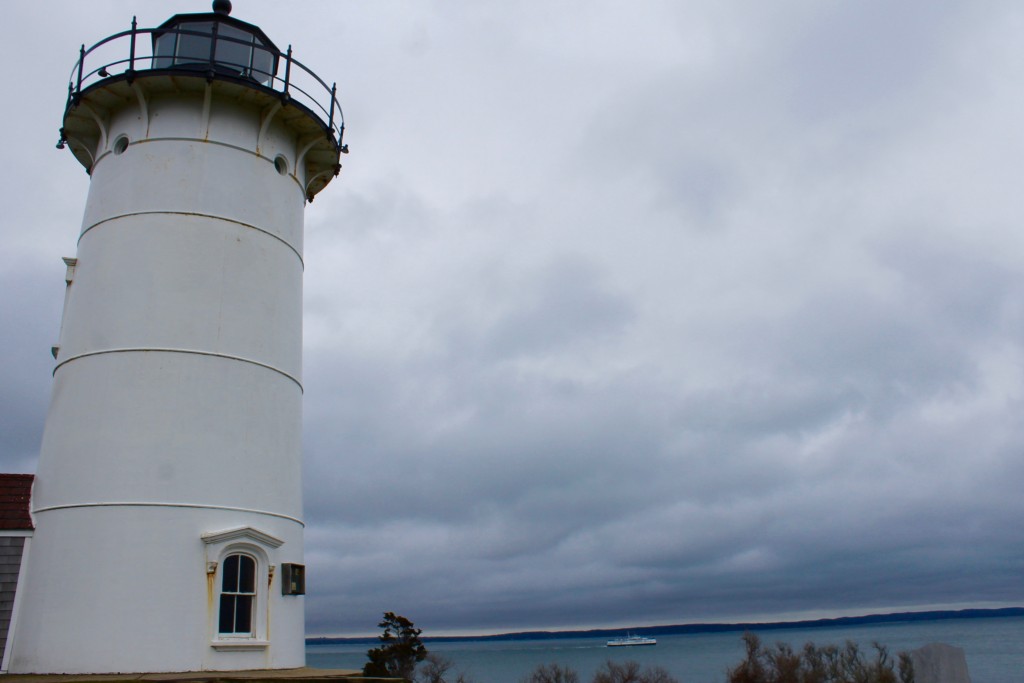
Despite the historic and continual need of a lighthouse as an aid to navigation, the facility is really part of the tourism business. It is a must-have photo for many visitors to Falmouth.
“On the face of it, it’s a cool place,” said Bumpus. “It’s beautiful. Because the Coast Guard chose high bluffs overlooking the water to send out signals and they wanted ships at sea to see them from a long way off, they were places high up with good views of the ocean. Fundamentally, lighthouses tend to be in beautiful locations.”
“It’s something many people recognize as being of Falmouth. It’s iconic to the community.” – Catherine Bumpus
“We’re lucky because we can drive right up to it,” said Bumpus. “There’s nothing blocking the view of sunrise to the east over Nantucket Sound. And the view to the west for sunset is lovely over the Elizabeth Islands and Woods Hole Passage.”
“Beyond that, there are many people for whom lighthouses are special for other reasons too. People get married there. Others are proud of the maritime traditions that have taken place there,” said Bumpus.
“And it’s something many people recognize as being of Falmouth,” said Bumpus. “It’s iconic to the community.”
RELATED LINKS:
On Facebook – Friends Of Nobska Light
